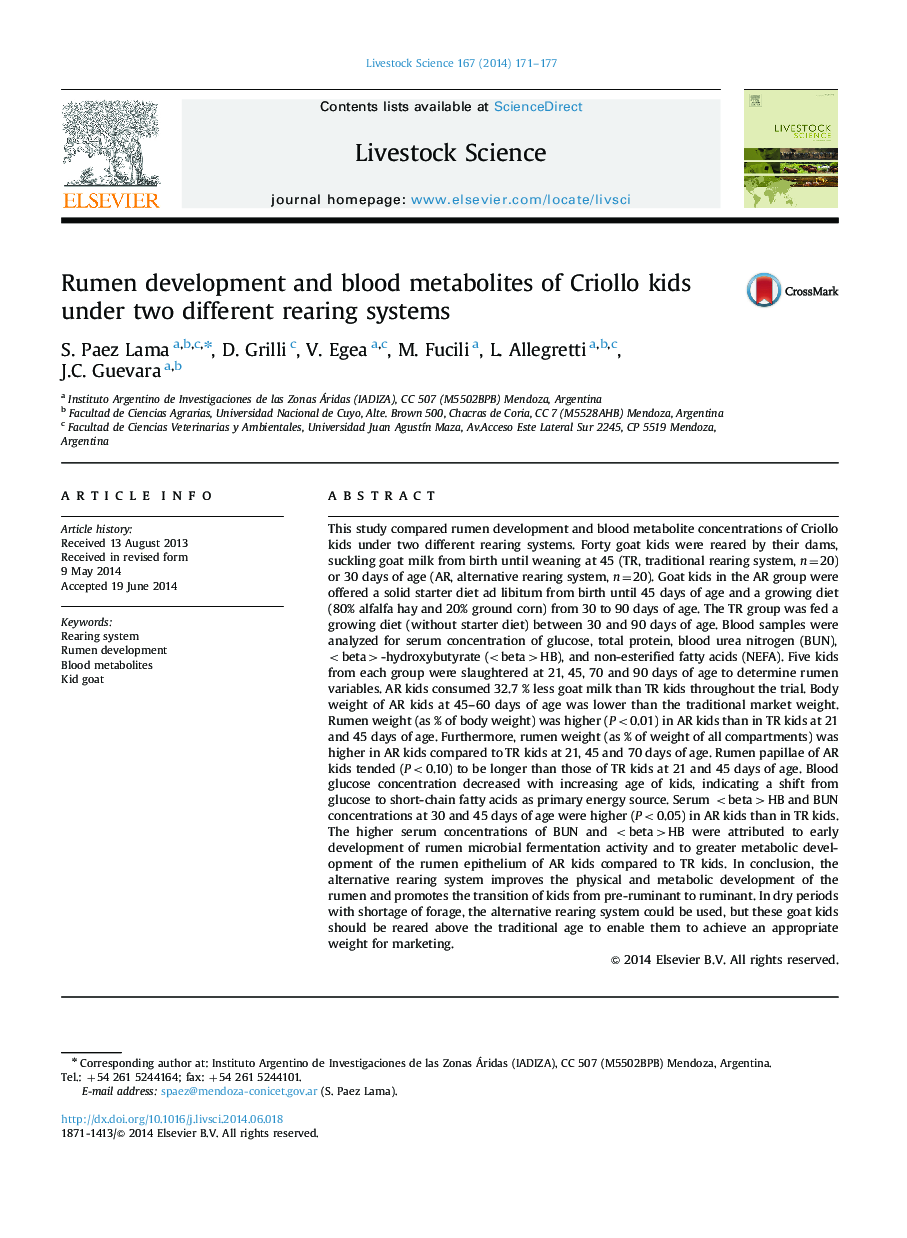| کد مقاله | کد نشریه | سال انتشار | مقاله انگلیسی | نسخه تمام متن |
|---|---|---|---|---|
| 5790089 | 1553965 | 2014 | 7 صفحه PDF | دانلود رایگان |
عنوان انگلیسی مقاله ISI
Rumen development and blood metabolites of Criollo kids under two different rearing systems
دانلود مقاله + سفارش ترجمه
دانلود مقاله ISI انگلیسی
رایگان برای ایرانیان
کلمات کلیدی
موضوعات مرتبط
علوم زیستی و بیوفناوری
علوم کشاورزی و بیولوژیک
علوم دامی و جانورشناسی
پیش نمایش صفحه اول مقاله

چکیده انگلیسی
This study compared rumen development and blood metabolite concentrations of Criollo kids under two different rearing systems. Forty goat kids were reared by their dams, suckling goat milk from birth until weaning at 45 (TR, traditional rearing system, n=20) or 30 days of age (AR, alternative rearing system, n=20). Goat kids in the AR group were offered a solid starter diet ad libitum from birth until 45 days of age and a growing diet (80% alfalfa hay and 20% ground corn) from 30 to 90 days of age. The TR group was fed a growing diet (without starter diet) between 30 and 90 days of age. Blood samples were analyzed for serum concentration of glucose, total protein, blood urea nitrogen (BUN), -hydroxybutyrate (HB), and non-esterified fatty acids (NEFA). Five kids from each group were slaughtered at 21, 45, 70 and 90 days of age to determine rumen variables. AR kids consumed 32.7 % less goat milk than TR kids throughout the trial. Body weight of AR kids at 45-60 days of age was lower than the traditional market weight. Rumen weight (as % of body weight) was higher (P<0.01) in AR kids than in TR kids at 21 and 45 days of age. Furthermore, rumen weight (as % of weight of all compartments) was higher in AR kids compared to TR kids at 21, 45 and 70 days of age. Rumen papillae of AR kids tended (P<0.10) to be longer than those of TR kids at 21 and 45 days of age. Blood glucose concentration decreased with increasing age of kids, indicating a shift from glucose to short-chain fatty acids as primary energy source. Serum HB and BUN concentrations at 30 and 45 days of age were higher (P<0.05) in AR kids than in TR kids. The higher serum concentrations of BUN and HB were attributed to early development of rumen microbial fermentation activity and to greater metabolic development of the rumen epithelium of AR kids compared to TR kids. In conclusion, the alternative rearing system improves the physical and metabolic development of the rumen and promotes the transition of kids from pre-ruminant to ruminant. In dry periods with shortage of forage, the alternative rearing system could be used, but these goat kids should be reared above the traditional age to enable them to achieve an appropriate weight for marketing.
ناشر
Database: Elsevier - ScienceDirect (ساینس دایرکت)
Journal: Livestock Science - Volume 167, September 2014, Pages 171-177
Journal: Livestock Science - Volume 167, September 2014, Pages 171-177
نویسندگان
S. Paez Lama, D. Grilli, V. Egea, M. Fucili, L. Allegretti, J.C. Guevara,